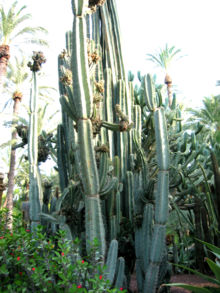Cereus (plant)
| Cereus | |
|---|---|
 |
|
| Cereus peruvianus | |
| Scientific classification | |
| Kingdom: | Plantae |
| (unranked): | Angiosperms |
| (unranked): | Eudicots |
| (unranked): | Core eudicots |
| Order: | Caryophyllales |
| Family: | Cactaceae |
| Subfamily: | Cactoideae |
| Tribe: | Cereeae |
| Genus: |
Cereus Mill. |
| Synonyms | |
|
Mirabella F.Ritter |
|
Mirabella F.Ritter
Piptanthocereus (A.Berger) Riccob.
Subpilocereus Backeb.
Cereus is a genus of cacti (family Cactaceae) including around 33 species of large columnar cacti from South America. The name is derived from Greek (κηρός) and Latin words meaning "wax" or "torch". The genus Cereus was one of the first cactus genera to be described; the circumscription varies depending on the authority. The term "cereus" is also sometimes used for a ceroid cactus, any cactus with a very elongated body, including columnar growth cacti and epiphytic cacti.
Cereus are shrubby or treelike, often attaining great heights (C. hexagonus, C. lamprospermus, C. trigonodendron up to 15 m). Most stems are angled or distinctly ribbed, ribs 3–14, usually well developed and have large areoles, usually bearing spines. Cephalium is not present, Cereus mortensenii develops pseudocephalium. Flowers are large, funnelform, 9–30 cm long, usually white, sometimes pink, purple, rarely cream, yellow, greenish, and open at night. Fruits are globose to ovoid to oblong, 3–13 cm long, fleshy, naked, usually red but sometimes yellow, pulp white, pink or red. Seeds large, curved ovoid, glossy black.
The name Cereus originates in a book by Tabernaemontanus published in 1625 and refers to the candle-like form of species Cereus hexagonus. Regularly having been described by Philip Miller in 1754, and included all known cacti with very elongated bodies.
Ludwig Pfeiffer in 1838 divided Cephalocereus (type Cephalocereus senilis), the name is derived from the Greek cephale, head, thus headed cereus, referring to the hairy pseudocephalium.Charles Lemaire described Pilocereus in 1839, now is renamed as Pilosocereus. The name Pilocereus is derived from the Greek pilos, felted, hairy, thus hairy cereus, similar to the Latin pilosus, from which the name Pilosocereus was derived.Echinocereus (type Echinocereus viridiflorus) was described in 1848 by George Engelmann, the name is derived from the Greek echinos, hedgehog or sea urchin.
...
Wikipedia
